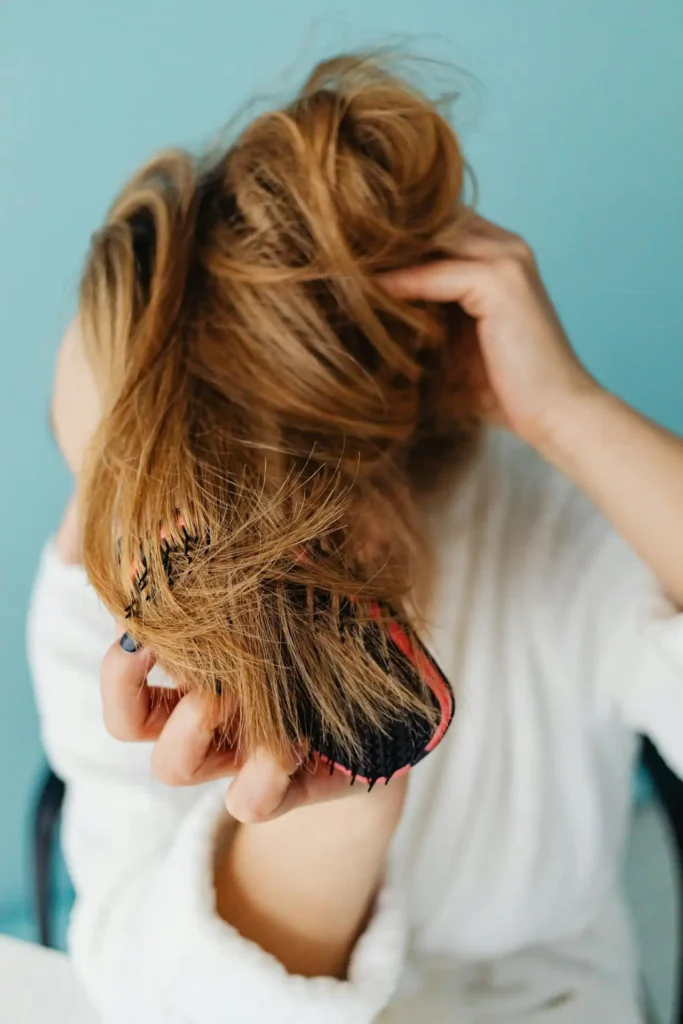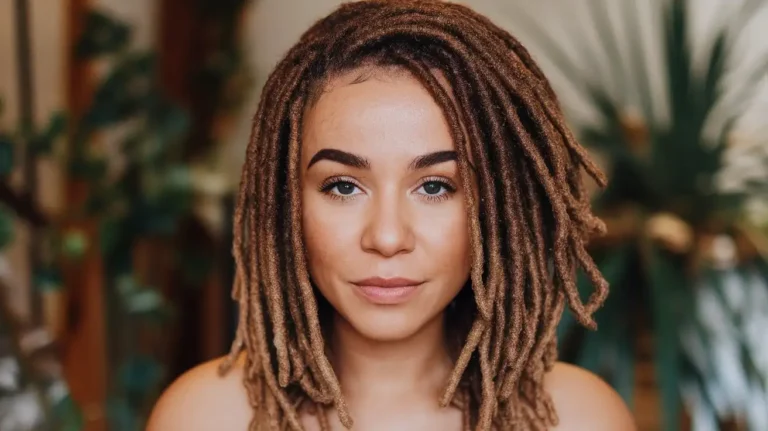The Ultimate Haircare Routine for Colored or Bleached Hair
You’ve just walked out of the salon with gorgeous new color, and your hair looks absolutely stunning. This leaves your strands more porous and vulnerable to damage.
But now comes the real challenge: keeping that vibrant shade looking fresh while maintaining your hair’s health.
Colored and bleached hair requires special attention because the chemical processes open your hair cuticles and strip away natural oils.
Don’t worry though – with the right routine and products, you can keep your colored hair looking salon-fresh for months.
Let’s dive into everything you need to know about caring for your newly transformed locks.
Understanding Your Colored Hair’s Unique Needs

When you color or bleach your hair, you’re fundamentally changing its structure.
The chemicals lift your hair’s natural pigment and deposit new color molecules. This process makes your hair more fragile and prone to breakage.
Your colored hair now has increased porosity, which means it absorbs and loses moisture more quickly than virgin hair.
This is why your hair might feel drier or more brittle after coloring. Understanding this change helps you choose the right products and techniques.
The good news is that with proper care, you can actually improve your hair’s condition over time.
Many people find their hair becomes shinier and more manageable once they establish a solid colored hair routine.
Pre-Wash Preparation: Setting Yourself Up for Success
Before you even step into the shower, you can take steps to protect your color. Start by gently detangling your hair with a wide-tooth comb or detangling brush.
Work from the ends up to avoid unnecessary pulling and breakage. If you’re planning to use heat styling tools later, now is the perfect time to apply a heat protectant.
Consider applying a pre-shampoo treatment once or twice a week. These treatments create a protective barrier that prevents your shampoo from stripping too much color.
You can use a commercial pre-wash treatment or simply apply a small amount of hair oil to your mid-lengths and ends.
Many people make the mistake of waiting until after washing, but applying protection to dry hair ensures better coverage and absorption.
The Art of Washing Colored Hair
Your washing technique can make or break your color’s longevity. Start by using lukewarm water instead of hot water.
Hot water opens your hair cuticles wider, allowing more color molecules to escape with each wash.
Apply shampoo primarily to your scalp and roots, where oil and buildup accumulate. Limit your washing frequency to 2-3 times per week if possible.
Let the suds rinse through your lengths naturally rather than scrubbing the entire length of your hair. This gentler approach prevents unnecessary color fade.
Your scalp produces natural oils that help protect your color and keep your hair healthy. Over-washing strips these beneficial oils and accelerates color fade.
When you do wash, use a color-safe shampoo specifically formulated for treated hair. These shampoos have a more balanced pH and contain fewer harsh sulfates that can strip color.
Choosing the Right Products for Your Hair Type
Not all color-safe products work the same for every hair type. If you have red hair, look for products with UV filters and antioxidants.
Fine hair needs lightweight formulas that won’t weigh it down, while thick, coarse hair can handle richer, more intensive treatments.
For blonde or platinum hair, consider purple or blue-toned shampoos once or twice a week.
These products neutralize brassy tones that naturally develop over time. However, don’t use them too frequently, as they can actually deposit too much pigment and dull your color.
Red is notoriously the fastest-fading color, so you need extra protection from environmental factors that cause color loss.
Brunettes and those with darker colors should focus on products that enhance shine and prevent fading from sun exposure.
Look for ingredients like argon oil and keratin that smooth the hair cuticle and lock in color.
Deep Conditioning: Your Color’s Best Friend
Deep conditioning treatments should become a weekly ritual in your colored hair routine.
These intensive treatments penetrate deeper into your hair shaft, providing moisture and nutrients that regular conditioner can’t deliver.
Apply your deep conditioning mask to damp hair, focusing on the mid-lengths and ends where damage is typically most severe.
Avoid the roots unless your scalp is particularly dry, as heavy conditioning at the roots can make your hair appear greasy.
Leave the treatment on for the recommended time – usually 10-20 minutes.
Some people like to apply gentle heat with a warm towel or shower cap to enhance penetration, but this isn’t necessary for most products.
Rinse thoroughly with cool water to seal the hair cuticles and lock in the treatment’s benefits. You should notice immediately softer, more manageable hair.
Heat Styling: Protecting Your Investment
Heat styling is one of the biggest threats to colored hair, but you don’t have to give up your styling tools entirely. The key is using proper protection and technique.
Always apply a heat protectant product to damp hair before blow-drying. If you must blow-dry, use the cool shot button to finish and seal your style.
These products create a barrier between your hair and the heat, reducing damage and color fade. Look for protectants that offer coverage up to at least 400°F.
Keep your styling tools at moderate temperatures. You might need to style for a bit longer, but the reduced heat will preserve your color and hair health.
Most colored hair does well with blow dryers on medium heat and styling tools around 300-350°F.
Consider air-drying when possible, especially during the first few weeks after coloring when your hair is most vulnerable.
Sun Protection for Your Hair

Just like your skin, your hair needs protection from UV rays. Sun exposure is one of the leading causes of color fade, particularly for vibrant or lighter shades.
Wear hats or scarves when spending extended time outdoors, especially during peak sun hours. If covering your hair isn’t practical, use a UV-protectant hair product.
Many leave-in conditioners and styling products now include SPF specifically for hair. This prevents your hair from absorbing as much pool or ocean water.
Chlorine and salt water are also harsh on colored hair. Before swimming, wet your hair with fresh water and apply a protective leave-in treatment.
After swimming, rinse immediately with fresh water and follow up with a clarifying shampoo if you’ve been in chlorinated water. Don’t let these chemicals sit on your hair longer than necessary.
Nighttime Care: Protecting Color While You Sleep
Your bedtime routine plays a crucial role in maintaining your color.
Cotton pillowcases can create friction that roughens your hair cuticles and causes color to fade faster. Switch to silk or satin pillowcases, which allow your hair to glide smoothly.
If you move around a lot in your sleep, consider loosely braiding your hair or putting it in a silk scrunchie. Avoid tight elastics that can cause breakage and damage to your colored strands.
Apply a small amount of hair oil or leave-in treatment to your ends before bed. This provides overnight nourishment and creates a protective coating that helps preserve your color.
Some people benefit from sleeping with a silk or satin hair bonnet, especially if you have longer hair that tends to tangle during the night.
Professional Maintenance: When to See Your Stylist
Even with the best at-home routine, you’ll need professional maintenance to keep your color looking its best.
Most colors need refreshing every 6-8 weeks, though this varies depending on your hair type and color choice. Don’t try to drastically change your color at home.
Book regular trim appointments every 6-8 weeks to remove damaged ends and maintain your style’s shape. Damaged ends can make even the most beautiful color look lackluster.
Consider professional deep conditioning treatments every few months. Salon treatments often use higher-quality ingredients and can penetrate deeper than at-home products.
Major color corrections or dramatic changes should always be handled by a professional to avoid damaging your hair or ending up with unwanted results.
Common Mistakes That Damage Colored Hair
One of the biggest mistakes people make is using regular drugstore shampoo on colored hair.
These shampoos often contain harsh sulfates that strip color quickly and can cause your investment to fade within weeks.
Over-processing is another common issue. Wait at least two weeks between chemical treatments, and always communicate with your stylist about any recent coloring, perming, or straightening treatments.
Many people use too much heat too often. While heat styling isn’t forbidden, daily high-heat styling will significantly reduce your color’s lifespan and damage your hair’s structure.
Skipping regular trims might seem like a way to grow your hair faster, but split ends can travel up the hair shaft and make your color look dull and damaged.
Nutrition and Lifestyle Factors
What you eat affects your hair’s health and appearance. Protein is essential for strong hair, so include plenty of lean meats, fish, eggs, and plant-based proteins in your diet.
Stay hydrated by drinking plenty of water throughout the day. Dehydrated hair is more prone to breakage and color fade.
Consider taking a biotin supplement or a comprehensive hair vitamin, but consult with your healthcare provider first.
Some people notice improved hair strength and growth with consistent supplementation.
Stress can affect your hair’s health and growth cycle. Practice stress management techniques like meditation, exercise, or adequate sleep to support overall hair health.
Seasonal Adjustments to Your Routine
Your hair’s needs change with the seasons, and your routine should adapt accordingly.
Winter air is typically drier, so you might need more intensive conditioning treatments during colder months.
Summer brings increased sun exposure and humidity, which can affect your color differently.
You might need more UV protection and lighter styling products that won’t weigh your hair down in humid conditions.
Spring and fall are excellent times for color refreshes and major changes, as the moderate weather is gentler on newly processed hair.
Adjust your washing frequency based on seasonal changes in your activity level and environment.
You might need to wash more frequently in summer due to increased sweating and sun exposure.
Troubleshooting Common Color Problems
If your color starts looking brassy or yellow, don’t panic. This is normal, especially for blonde and silver shades. Use a purple shampoo once or twice a week to neutralize unwanted tones.
Rapid color fade can indicate that your hair is over-porous. Increase your deep conditioning treatments and consider using a protein treatment to help close the hair cuticles.
If your hair feels dry and brittle, focus on moisture-rich products and reduce heat styling. Sometimes taking a break from coloring for a few months can help restore your hair’s health.
Color that looks dull might simply need a professional gloss treatment. These semi-permanent treatments add shine and can refresh your color between major appointments.
Building Your Personal Routine

Start by assessing your hair’s current condition and your lifestyle needs. Someone who exercises daily will have different washing requirements than someone with a more sedentary routine.
Introduce new products gradually to see how your hair responds. Not every product works for every person, even within the same hair type category.
Keep a hair diary for the first few months after coloring. Note which products work well, how your hair responds to different techniques, and when you notice color changes.
Remember that consistency is key. A simple routine followed regularly will give better results than an elaborate routine used sporadically.
Conclusion
Your colored hair journey doesn’t end when you leave the salon – it’s just beginning.
With the right care routine, quality products, and consistent attention, you can keep your color vibrant and your hair healthy for months to come.







